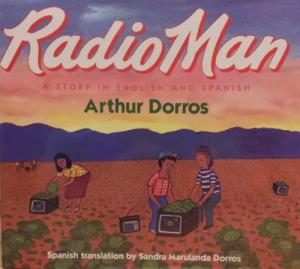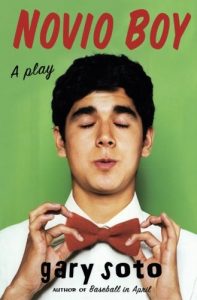 Ninth grader Rudy has a date with eleventh grader Patricia. Now he has to come up with the money, the poise, and the conversation to carry it off. This one-act play, by turns heartwarming and heart-wrenching, follows Rudy from his desperate search for guidance through the hilarious date itself–all the way to its happy conclusion. Includes a glossary of Spanish phrases.
Ninth grader Rudy has a date with eleventh grader Patricia. Now he has to come up with the money, the poise, and the conversation to carry it off. This one-act play, by turns heartwarming and heart-wrenching, follows Rudy from his desperate search for guidance through the hilarious date itself–all the way to its happy conclusion. Includes a glossary of Spanish phrases.
North America
Radio Man/Don Radio
Chupacabra and the Roswell UFO
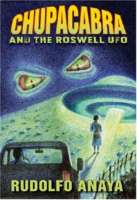
In this second ChupaCabra mystery, Professor Rosa Medina has just arrived in Santa Fe where she meets Nadine, a mysterious sixteen-year-old who insists that the two of them travel to Roswell, New Mexico. Nadine is convinced that C-Force, a secret government agency, has decoded the DNA of ChupaCabra and an extraterrestrial. If the two genomes are combined, a new and horrific life form will be created.In this fast-paced mystery, Anaya expands the ChupaCabra folklore into a metaphor that deals with the new powers inherent in science. Is ChupaCabra a beast in Latino folktales, used to frighten children, or a lost species being manipulated by C-Force? Rosa\’s life hangs in the balance as she and her young accomplice try to find a way to stop C-Force before its mad scientists create a monster.
Conversations with Contemporary Chicana and Chicano Writers
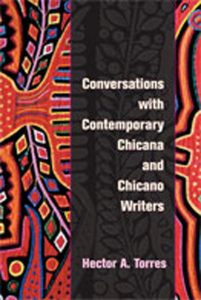 Hector A. Torres conducted these interviews with today’s popular Chicano/a writers, asking each about language and life between languages, about the creative drive that has guided them in their craft and commits them to their art. In sharing their responses, Torres reveals a brief biography of each author and a concise examination of their writings. Taking their stories and essays individually and collectively, Torres explains how each author reiterates issues that have concerned Mexican Americans since at least 1848. Chicano/a authors know that an abundance of politics can spoil a story, as can too little. The writers included here span historical terrain, first, under the shadow of Manifest Destiny and, then, under the America’s imperial sovereignty stance. Interviewees include Rolando Hinojosa (“I Reflect the Way Valleyites Act and React”), Arturo Islas (“I Don’t Like Labels and Categories”), Erlinda Gonzales-Berry (“On the New Mexican Borderlands”), Gloria Anzaldúa (“The Author Never Existed”), Ana Castillo (two separate interviews), Sandra Cisneros (two separate interviews), Pat Mora (“I Was Always at Home in Language”), Richard Rodriguez (“I Don’t Think I Exist”), Demetria Martinez (“To Speak as Global Citizens”), and Kathleen Alcalá (“To Tell the Counternarratives”).
Hector A. Torres conducted these interviews with today’s popular Chicano/a writers, asking each about language and life between languages, about the creative drive that has guided them in their craft and commits them to their art. In sharing their responses, Torres reveals a brief biography of each author and a concise examination of their writings. Taking their stories and essays individually and collectively, Torres explains how each author reiterates issues that have concerned Mexican Americans since at least 1848. Chicano/a authors know that an abundance of politics can spoil a story, as can too little. The writers included here span historical terrain, first, under the shadow of Manifest Destiny and, then, under the America’s imperial sovereignty stance. Interviewees include Rolando Hinojosa (“I Reflect the Way Valleyites Act and React”), Arturo Islas (“I Don’t Like Labels and Categories”), Erlinda Gonzales-Berry (“On the New Mexican Borderlands”), Gloria Anzaldúa (“The Author Never Existed”), Ana Castillo (two separate interviews), Sandra Cisneros (two separate interviews), Pat Mora (“I Was Always at Home in Language”), Richard Rodriguez (“I Don’t Think I Exist”), Demetria Martinez (“To Speak as Global Citizens”), and Kathleen Alcalá (“To Tell the Counternarratives”).
Los Gatos Black On Halloween
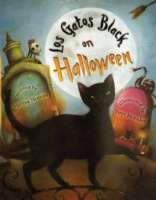
Follow los monstruos and los esqueletos to the Halloween party Under October’s luna, full and bright, the monsters are throwing a ball in the Haunted Hall. Las brujas come on their broomsticks. Los muertos rise from their coffins to join in the fun. Los esqueletos rattle their bones as they dance through the door. And the scariest creatures of all aren’t even there yet!This lively bilingual Halloween poem introduces young readers to a spooky array of Spanish words that will open their ojos to the chilling delights of the season.
Angel City
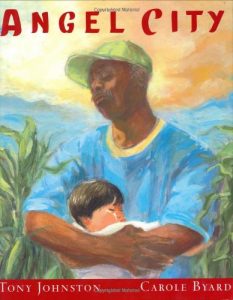 Old man Joseph never imagined a family could start this way. When he finds a baby abandoned on a lonely L.A. street, he vows to raise it as his own. He’s an old farmer and knows nothing of parenting, even less about raising a Mexican baby.Yet Joseph keeps his promise and with time he realizes that even in the darkest barrio, there is a world to explore, songs and stories to be shared. Even in the darkest barrio, there is love.
Old man Joseph never imagined a family could start this way. When he finds a baby abandoned on a lonely L.A. street, he vows to raise it as his own. He’s an old farmer and knows nothing of parenting, even less about raising a Mexican baby.Yet Joseph keeps his promise and with time he realizes that even in the darkest barrio, there is a world to explore, songs and stories to be shared. Even in the darkest barrio, there is love.
Illustrated by Caldecott-Honor Medal winner Carol Byard and beautifully told by Tony Johnston, Angel City is a moving tribute to the strength of family no matter its form.
The Perfect Pinata/La Pinata Perfecta
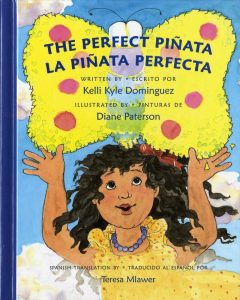 Marisa’s sixth birthday was drawing near, and today her mother took her to buy a piñata. At the store, Marisa saw a beautiful butterfly piñata and knew she had to have it. “It’s perfect for my party!” she exclaimed. When they brought the piñata home, her mother wanted to put it in the closet, but Marisa begged to keep it on her dresser. That week Marisa took her butterfly everywhere, and it watched over her at night while she slept. The morning of the party, Mama filled the piñata with candy and toys. Soon the guests arrived. It was time to hit the piñata! Marisa was the first in line. But the butterfly looked down at her with its happy eyes, and Marisa started to cry. “I can’t do it!” she said as she ran into the house.
Marisa’s sixth birthday was drawing near, and today her mother took her to buy a piñata. At the store, Marisa saw a beautiful butterfly piñata and knew she had to have it. “It’s perfect for my party!” she exclaimed. When they brought the piñata home, her mother wanted to put it in the closet, but Marisa begged to keep it on her dresser. That week Marisa took her butterfly everywhere, and it watched over her at night while she slept. The morning of the party, Mama filled the piñata with candy and toys. Soon the guests arrived. It was time to hit the piñata! Marisa was the first in line. But the butterfly looked down at her with its happy eyes, and Marisa started to cry. “I can’t do it!” she said as she ran into the house.
Numero Uno
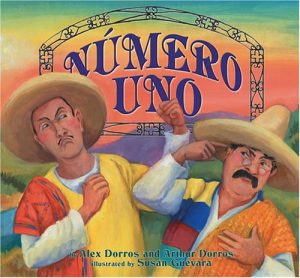 A bilingual picture book that will be #1 this spring! From a talented team, this hilarious tale of competition run amok is told with a sprinkling of Spanish and a heaping spoonful of charm. Which is better, brains or brawn? In a small village, Hercules is known for his great strength and Socrates for his keen intelligence. Whenever the villagers have a problem, they go to one or the other for help. Each man believes that he is the most important person in town. And the two fight about it constantly. Who, their neighbors wonder, will resolve the question that instigates all this bickering? The villagers realize they must settle the argument once and for all by finding out who is “número uno.” They devise a clever test, and Hercules and Socrates, each sure he will win, go along with it. The answer is a surprise for everyone “I came up with the idea for Número Uno in sixth grade when the class was asked to write fables. I thought that these two characters, one with outstanding intelligence and one with exceptional brawn, would together create an entertaining story. It could also carry a valuable lesson, as fables do. The story was originally set in China, but to me it is universal. We later decided to change to a Spanish-speaking setting, which I am more familiar with. “I grew up bilingual, speaking English and Spanish, and have visited many Latin American countries, including going to school there for a short while. I’m now sixteen years old and am enjoying living in Seattle. I spend much of my free time going to the nearby mountains (like Hercules and Socrates do in the book), in my case to snowboard. I also create my own stories through taking photographs, a few of which have now been published. I stay busy with playing baseball and going to high school. “As we wrote the book, the story stayed essentially as I originally had it, though we went through seemingly endless numbers of revisions and ended up changing details in the process. Writing a book with your dad is definitely not the easiest of tasks. At some points we reminded ourselves of the bickering characters in the story. Ultimately we were able to work together to create what I hope is a book you’ll enjoy.”—Alex Dorros on the creation of Número Uno with his father Arthur Dorros
A bilingual picture book that will be #1 this spring! From a talented team, this hilarious tale of competition run amok is told with a sprinkling of Spanish and a heaping spoonful of charm. Which is better, brains or brawn? In a small village, Hercules is known for his great strength and Socrates for his keen intelligence. Whenever the villagers have a problem, they go to one or the other for help. Each man believes that he is the most important person in town. And the two fight about it constantly. Who, their neighbors wonder, will resolve the question that instigates all this bickering? The villagers realize they must settle the argument once and for all by finding out who is “número uno.” They devise a clever test, and Hercules and Socrates, each sure he will win, go along with it. The answer is a surprise for everyone “I came up with the idea for Número Uno in sixth grade when the class was asked to write fables. I thought that these two characters, one with outstanding intelligence and one with exceptional brawn, would together create an entertaining story. It could also carry a valuable lesson, as fables do. The story was originally set in China, but to me it is universal. We later decided to change to a Spanish-speaking setting, which I am more familiar with. “I grew up bilingual, speaking English and Spanish, and have visited many Latin American countries, including going to school there for a short while. I’m now sixteen years old and am enjoying living in Seattle. I spend much of my free time going to the nearby mountains (like Hercules and Socrates do in the book), in my case to snowboard. I also create my own stories through taking photographs, a few of which have now been published. I stay busy with playing baseball and going to high school. “As we wrote the book, the story stayed essentially as I originally had it, though we went through seemingly endless numbers of revisions and ended up changing details in the process. Writing a book with your dad is definitely not the easiest of tasks. At some points we reminded ourselves of the bickering characters in the story. Ultimately we were able to work together to create what I hope is a book you’ll enjoy.”—Alex Dorros on the creation of Número Uno with his father Arthur Dorros
Sundays on Fourth Street / Los Domingos En La Calle Cuatro
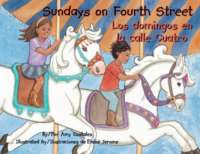
”My cousin Pepe combs my hair back just like his, and Aunt Pilar laughs. Then she slides her red lipstick across my lips, but Mama wipes it off because I’m too young. Mama puts on her new jeans, and Aunt Pilar polishes her high heels. Uncle Armando finishes washing his old car.” And then, a young girl and her family pile into the shiny car, grown-ups in the front, and kids in the back, and head to Fourth Street.Sundays spent on Fourth Street are magical, family outings that three young cousins eagerly anticipate. Strolling down Fourth Street with their parents, the children encounter a bustling wonderland filled with music, food, and fun. The cousins savor sharp bursts of flavor from mangos on a stick covered with lemon, chili and salt; delight in the sight of folk dancers spinning in the plaza; revel in rides and raffles at the church carnival; and yearn for clothes and toys they see in shop windows. While the children may not get the things that so often catch their attention, they can always look forward to more fun together next Sunday on Fourth Street. Based on real-life visits to Fourth Street in Santa Ana, California, author Amy Costales has written a story that pays homage to a special street and, more importantly, time spent with loved ones. Paired with Elaine Jerome’s colorful illustrations that depict lively street scenes, readers of all ages will enjoy Sundays on Fourth Street.
The Tequila Worm
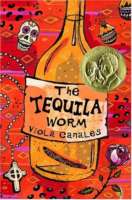
Sofia comes from a family of storytellers. Here are her tales of growing up in the barrio in McAllen, Texas, full of the magic and mystery of family traditions: making Easter cascarones, celebrating el Dia de los Muertos, preparing for quinceañera, rejoicing in the Christmas nacimiento, and curing homesickness by eating the tequila worm. When Sofia is singled out to receive a scholarship to boarding school, she longs to explore life beyond the barrio, even though it means leaving her family to navigate a strange world of rich, privileged kids. It’s a different mundo, but one where Sofia’s traditions take on new meaning and illuminate her path.

